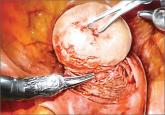by Javier F. Magrina, MD, and colleagues
Video courtesy of Javier F. Magrina, MD, Professor, Obstetrics-Gynecology, Mayo Clinic, Phoenix, Arizona; Immediate Past President, AAGL
Open morcellation of uterine fibroids may result in the dispersion of bits of tissue around the peritoneal cavity and surgical ports. If the fibroid contains genetic mutations that significantly increase the growth potential of fibroid cells, fibroid nodules may grow postoperatively in the pelvis, abdomen, and surgical ports. Investigators have called these disseminated nodules of fibroid tumor, “morcellomas.”
by Javier F. Magrina, MD, and colleagues
Video courtesy of Javier F. Magrina, MD, Professor, Obstetrics-Gynecology, Mayo Clinic, Phoenix, Arizona; Immediate Past President, AAGL
View Dr. Magrina and colleagues' technique for the vaginal approach to open hand morcellation of a normal-sized uterus with a colpotomy incision during hysterectomy.
by John B. Gebhart, MD, and colleagues
Video courtesy of John B. Gebhart, MD, Associate Professor and Fellowship Program Director, Mayo Clinic, Rochester, Minnesota
Watch Dr. Gebhart and colleagues' surgical technique for the vaginal approach to open hand morcellation of a large uterus with a colpotomy incision. It is critical to secure the uterine vessels before morcellation begins, and it is preferable to have entered both cul-de-sacs as well. Once those steps have been accomplished, bi-valve the cervix in the midline, following the endocervical canal to stay in the midline. Use a tenaculum to grasp bites of the uterus in an anterior and posterior fashion. This step reduces uterine size until the fundus can be inverted and the utero-ovarian pedicles secured.
WE WANT TO HEAR FROM YOU. Tell us what you think.
